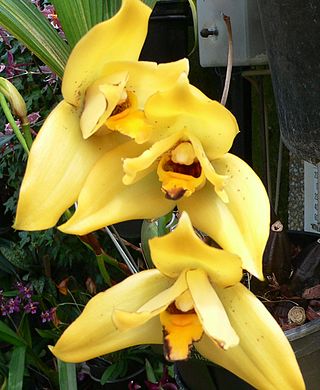
In taxonomy, binomial nomenclature, also called binary nomenclature, is a formal system of naming species of living things by giving each a name composed of two parts, both of which use Latin grammatical forms, although they can be based on words from other languages. Such a name is called a binomial name, a binomen, binominal name, or a scientific name; more informally it is also historically called a Latin name. In the ICZN, the system is also called binominal nomenclature, "binomi'N'al" with an "N" before the "al", which is not a typographic error, meaning "two-name naming system".

A cultivar is a kind of cultivated plant that people have selected for desired traits and which retains those traits when propagated. Methods used to propagate cultivars include division, root and stem cuttings, offsets, grafting, tissue culture, or carefully controlled seed production. Most cultivars arise from deliberate human manipulation, but some originate from wild plants that have distinctive characteristics. Cultivar names are chosen according to rules of the International Code of Nomenclature for Cultivated Plants (ICNCP), and not all cultivated plants qualify as cultivars. Horticulturists generally believe the word cultivar was coined as a term meaning "cultivated variety".

In botanical nomenclature, variety is a taxonomic rank below that of species and subspecies, but above that of form. As such, it gets a three-part infraspecific name. It is sometimes recommended that the subspecies rank should be used to recognize geographic distinctiveness, whereas the variety rank is appropriate if the taxon is seen throughout the geographic range of the species.

In botany and plant taxonomy, a series is a subdivision of a genus, a taxonomic rank below that of section but above that of species.

A botanical name is a formal scientific name conforming to the International Code of Nomenclature for algae, fungi, and plants (ICN) and, if it concerns a plant cultigen, the additional cultivar or Group epithets must conform to the International Code of Nomenclature for Cultivated Plants (ICNCP). The code of nomenclature covers "all organisms traditionally treated as algae, fungi, or plants, whether fossil or non-fossil, including blue-green algae (Cyanobacteria), chytrids, oomycetes, slime moulds and photosynthetic protists with their taxonomically related non-photosynthetic groups ."
An epithet is a name. In taxonomic nomenclature, it is a word or phrase (epithet) in the name of an organism. It can be:

In taxonomy, a nomen nudum is a designation which looks exactly like a scientific name of an organism, and may have originally been intended to be one, but it has not been published with an adequate description. This makes it a "bare" or "naked" name, which cannot be accepted as it stands. A largely equivalent but much less frequently used term is nomen tantum. Sometimes, "nomina nuda" is erroneously considered a synonym for the term "unavailable names". However, not all unavailable names are nomina nuda.
Botanical nomenclature is the formal, scientific naming of plants. It is related to, but distinct from taxonomy. Plant taxonomy is concerned with grouping and classifying plants; botanical nomenclature then provides names for the results of this process. The starting point for modern botanical nomenclature is Linnaeus' Species Plantarum of 1753. Botanical nomenclature is governed by the International Code of Nomenclature for algae, fungi, and plants (ICN), which replaces the International Code of Botanical Nomenclature (ICBN). Fossil plants are also covered by the code of nomenclature.
In botany, an infraspecific name is the scientific name for any taxon below the rank of species, i.e. an infraspecific taxon or infraspecies. A "taxon", plural "taxa", is a group of organisms to be given a particular name. The scientific names of botanical taxa are regulated by the International Code of Nomenclature for algae, fungi, and plants (ICN). This specifies a three part name for infraspecific taxa, plus a connecting term to indicate the rank of the name. An example of such a name is Astrophytum myriostigma subvar. glabrum, the name of a subvariety of the species Astrophytum myriostigma.
The International Code of Nomenclature for Cultivated Plants (ICNCP) is a guide to the rules and regulations for naming cultigens, plants whose origin or selection is primarily due to intentional human activity. It is also known as Cultivated Plant Code. Cultigens under the purview of the ICNCP include cultivars, Groups, and grexes. All organisms traditionally considered to be plants are included. Taxa that receive a name under the ICNCP will also be included within taxa named under the International Code of Nomenclature for algae, fungi, and plants, for example, a cultivar is a member of a species.
In botanical nomenclature, a hybrid may be given a hybrid name, which is a special kind of botanical name, but there is no requirement that a hybrid name should be created for plants that are believed to be of hybrid origin. The International Code of Nomenclature for algae, fungi, and plants (ICNafp) provides the following options in dealing with a hybrid:
A cultigen, or cultivated plant, is a plant that has been deliberately altered or selected by humans, by means of genetic modification, graft-chimaeras, plant breeding, or wild or cultivated plant selection. These plants have commercial value in horticulture, agriculture and forestry. Plants meeting this definition remain cultigens whether they are naturalised, deliberately planted in the wild, or grown in cultivation.
An International Cultivation Registration Authority (ICRA) is an organization responsible for ensuring that the names of plant cultivars and cultivar groups are defined and not duplicated.

Priority is a fundamental principle of modern botanical nomenclature and zoological nomenclature. Essentially, it is the principle of recognising the first valid application of a name to a plant or animal. There are two aspects to this:
- The first formal scientific name published for a plant or animal taxon shall be the name that is to be used, called the valid name in zoology and correct name in botany.
- Once a name has been used, no subsequent publication of that name for another taxon shall be valid (zoology) or validly published (botany).

In biology, taxonomic rank is the relative level of a group of organisms in an ancestral or hereditary hierarchy. A common system of biological classification (taxonomy) consists of species, genus, family, order, class, phylum, kingdom, and domain. While older approaches to taxonomic classification were phenomenological, forming groups on the basis of similarities in appearance, organic structure and behaviour, methods based on genetic analysis have opened the road to cladistics.
Horticultural botany is the study of the botany of current and potential cultivated plants, with emphasis on the ornamental plants of horticulture, by a horticultural botanist or plantsman—plantsperson."

Cultivated plant taxonomy is the study of the theory and practice of the science that identifies, describes, classifies, and names cultigens—those plants whose origin or selection is primarily due to intentional human activity. Cultivated plant taxonomists do, however, work with all kinds of plants in cultivation.

The term grex, derived from the Latin noun grex, gregis, meaning 'flock', has been expanded in botanical nomenclature to describe hybrids of orchids, based solely on their parentage. Grex names are one of the three categories of plant names governed by the International Code of Nomenclature for Cultivated Plants; within a grex the cultivar group category can be used to refer to plants by their shared characteristics, and individual orchid plants can be selected and named as cultivars.
Solanum tuberosum Group Phureja is a cultivar-group of diploid potato plants originating from the Andes in South America. The group differs from other potato cultivar-groups by the absence of dormant tubers. This means that the tuber immediately begins to grow once it is formed, without a resting period. This explains why the varieties of the group are to be planted in areas with a mild climate, where culture throughout the year is possible. By hybridization with Solanum tuberosum by the Scottish Crop Research Institute, varieties were obtained who are adapted to the European climate. These crossings are particularly popular as a culinary potato for their excellent taste.

This is a list of terms and symbols used in scientific names for organisms, and in describing the names. For proper parts of the names themselves, see List of Latin and Greek words commonly used in systematic names. Note that many of the abbreviations are used with or without a stop.









